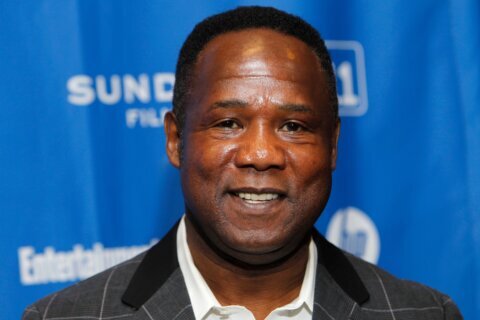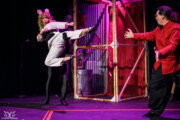WASHINGTON — It’s only July, but “Dunkirk” just inspired a few Academy Award predictions.
Writer/director Christopher Nolan is positioned to win his overdue Oscar for Best Director, which is about time after “Memento” (2000), “The Dark Knight” (2008) and “Inception” (2010). It won’t be a make-up award; it will be a deserving honor for the directorial prowess on display.
But like “Gravity” (2013) and “The Revenant” (2015), “Dunkirk” may not even earn a script nomination, which could hurt its Best Picture chances. It feels more like an IMAX attraction at the Smithsonian Air & Space Museum, where it made its D.C. premiere with Nolan on hand.
Thus, your personal preference for either visual ethos (directing, cinematography, editing) or character pathos (screenplay, performance, tone) will determine your reaction to “Dunkirk,” a viscerally stunning, relentlessly intense, albeit emotionally chilly, sensory experience meant to be seen on the largest screen possible. Just take a deep breath beforehand — you’ll need it.
Based on true World War II events that Winston Churchill called “The Miracle of Dunkirk,” Allied forces launch Operation Dynamo to evacuate 338,226 soldiers from Belgium, Britain and France. They’re surrounded by Germans off the coast of Dunkirk, France, along the English Channel from May 26 to June 4, 1940. The story unfolds across three storylines:
(A) “The Mole” (land pier) follows a British soldier (Fionn Whitehead) stranded alongside his fellow troops (Aneurin Barnard, Harry Styles), naval commander (a stoic Kenneth Branagh) and army colonel (James D’Arcy). This land storyline unfolds over the course of one week.
(B) “The Sea” follows a wise, civilian sailor (Mark Rylance, “Bridge of Spies”), his devoted son (Tom Glynn-Carney) and an eager tag-along (Barry Keoghan), who embark across the English Channel on a rescue mission in nothing but their humble yacht, picking up a shellshocked torpedo survivor (Cillian Murphy) along the way. This all unfolds over the course of one day.
(C) “The Air” follows a Royal Air Force Spitfire pilot (Tom Hardy) dogfighting with German fighter planes. This storyline of aerial maneuvers unfolds over the course of one hour.
It’s an ambitious setup to be sure, one that’s probably more complicated than it needs to be. In any event, the cinesthetics are amazing, combining practical effects, thousands of extras and the kind of action that recalls Wolfgang Petersen’s submarine classic “Das Boot” (1981). Note that we never see the enemy’s faces, instead focusing on the Allied survival instincts.
There are images in “Dunkirk” you’ll never forget. Some are mundane, such as a thirsty mouth gasping for droplets of water from a hose. Others are kinetic: the light of a torpedo streaking across the water; a soldier’s face pressed against the beach as explosions start in the distance and move closer until sand hits the camera; or a pilot trapped in the cockpit as his fighter jet becomes increasingly submerged under water. It’s the stuff that storyboards are made of.
Hats off to cinematographer Hoyte Van Hoytema, who shot the Swedish horror masterpiece “Let the Right One In” (2008) and came to Hollywood for “The Fighter” (2010) and “Her” (2013) before hooking up with Nolan on “Interstellar” (2014). Together, they shift between 70 mm film and IMAX (75 percent), a mixed-format approach Nolan adores (i.e. “Dark Knight Rises”).
Nolan also taps his other favorite collaborators, including editor Lee Smith, who’s edited every one of Nolan’s films since “Batman Begins” (2005), and composer Hans Zimmer, who scored “The Dark Knight Trilogy” (2005-2012), “Inception” (2010) and “Interstellar” (2014). If you love Zimmer’s work, you can see him conduct live at Merriweather on Friday. In “Dunkirk,” it’s a piercing array of mechanical sounds and ticking clocks that keep the tension at fever pitch.
This sensory attack is both the film’s trademark and Achilles heel, a relentless approach that borders on exhaustion, even at 107 minutes. Imagine the opening of “Saving Private Ryan” (1998) for an entire movie. You’ll wish Nolan would pause occasionally and let us get to know the characters. While Spielberg is knocked for sentimentality, just a touch of it (i.e. “Gravity”) would have gone a long way to make “Dunkirk” more heartfelt and less cold and clinical.
Of course, you can’t pause for monologues when you’re under constant fire, a decision Nolan made at the inception (forgive the pun). Writing without brother Jonathan, Nolan penned 76 pages of action description. There is hardly any dialogue in the film, which is refreshing — more movies should talk less and show more — but the remaining dialogue is drowned out by the bold score, while the breakneck pace leaves little time for character development.
No, this is an experimental survival tale akin to Alejandro G. Iñárritu’s “The Revenant” (2015), introducing obstacle after obstacle, but instead of focusing on a central character, “Dunkirk” spreads its protagonists across three storylines. These plots aren’t so much parallel action as they are overlapping action (week on land, day at sea, hour in the air). Doubling and tripling back on itself, the complex chronology may require a second viewing to catch all the tie-ins.
Nolan’s puzzle mentality dates back to his breakthrough “Memento,” which will cause fans to debate where “Dunkirk” ranks in the auteur‘s canon. Some critics are calling it his finest work, but I won’t go that far. “Dunkirk” is an impressive feat, but “Memento,” “The Dark Knight” and “Inception” were more well-rounded because they offered more character work, tattooing memories on our bodies, carving smiles across our faces and planting thoughts in our brains.
Since then, Nolan has dangerously teetered toward indulgence, choosing grand concepts over basic story structure in “Interstellar.” Thankfully, “Dunkirk” is far less voluminous. Still, I fear that his recent “event movies” won’t transition across platforms. When award voters sit down to re-watch “Dunkirk” on DVD screeners, the small screen won’t be as kind to the visceral elements, exposing thin characters that are, for now, masked by an immersive atmosphere.
Movies, like a verb, should move us. After “Dunkirk” ended, I was technically impressed, but didn’t feel it deep in my soul. Instead, I staggered out feeling like I’d just had my ass kicked, which I suppose is the point. Still, for an event that Churchill called “The Miracle of Dunkirk,” we should feel some spiritual illumination. Instead, Nolan settles for “The Horrors of Dunkirk,” which is striking enough to take directing gold, but may leave some folks emotionally distant.
In the end, you may not come away loving “Dunkirk,” but it’s hard as hell not to respect it.









